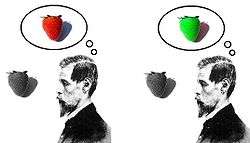Inverted spectrum
Inverted spectrum is the hypothetical concept of two people sharing their color vocabulary and discriminations, although the colors one sees — one's qualia — are systematically different from the colors the other person sees.

The concept dates back to John Locke.[1] It invites us to imagine that we wake up one morning, and find that for some unknown reason all the colors in the world have been inverted. Furthermore, we discover that no physical changes have occurred in our brains or bodies that would explain this phenomenon. Supporters of the hypothesis of qualia as non-physical entities argue that, since we can imagine this happening without contradiction, it follows that we are imagining a change in a property that determines the way things look to us, but that has no physical basis. In more detail:
- Metaphysical identity holds of necessity
- If something is possibly false, it is not necessary
- It is conceivable that qualia could have a different relationship to physical brain-states
- If it is conceivable, then it is possible
- Since it is possible for qualia to have a different relationship with physical brain-states, they cannot be identical to brain states (by 1).
- Therefore, qualia are non-physical.
The argument thus states that if we find the inverted spectrum plausible, we must admit that qualia exist (and are non-physical). Some philosophers find it absurd that an "armchair argument" can prove something to exist, and the detailed argument does involve many assumptions about conceivability and possibility, which are open to criticism. Perhaps it is not possible for a given brain state to produce anything other than a given quale in our universe, and that is all that matters.
The idea that an inverted spectrum would be undetectable is also open to criticism on more scientific grounds:[2][3]
| “ | there are more perceptually distinguishable shades between red and blue than there are between green and yellow, which would make red-green inversion behaviorally detectable.[1 And there are yet further asymmetries. Dark yellow is brown (qualitatively different from yellow), whereas dark blue is blue[..] Similarly, desaturated bluish-red is pink (qualitatively different from saturated bluish-red), whereas desaturated greenish-yellow is similar to saturated greenish-yellow. Again, red is a “warm” color, whereas blue is “cool” — and perhaps this is not a matter of learned associations with temperature. | ” |
Inverted spectrum arguments have applications to behavioralism, physicalism, representationalism, functionalism, skepticism and the hard problem of consciousness.
In his book I Am A Strange Loop, Douglas Hofstadter argues that the inverted spectrum argument entails a form of solipsism in which people can have no idea about what goes on in the minds of others—contrary to the central theme of his work. He presents several variants to demonstrate the absurdity of this idea: the "inverted political spectrum", in which one person's concept of liberty is identical to another's concept of imprisonment; an inverted "sonic spectrum" in which low musical notes sound like "high" ones and vice versa (which he says is impossible because low sounds can be felt physically as vibrations); and a version in which random, complex qualia such as riding a roller coaster or opening presents are reversed, so that everyone perceives the world in radically different, unknowable ways.
Controversy
This philosophical reasoning isn't supported by scientific data. Some people might perceive colors differently but due to physiological abnormalities. Color seems to have a causal relationship between frequency, receptors and spectrum management in the brain. For an average brain color isn't generated at random. The rainbow sequence has a causal relationship between frequency and the average brain processing. The order of the rainbow sequence seems to have an emotional harmonious cause that corresponds to specific bain waves. Even people that perceive colors differently, have physiological reasons. Nowadays we need more data to explain the order of the rainbow sequence.
Notes
- ↑ (In this passage, Locke uses "idea" to mean something like "mental image", rather than its modern meaning. He also uses "texture" to mean the physical property that gives rise to a color-sensation) "Neither would it carry any Imputation of Falshood to our simple Ideas, if by the different Structure of our Organs, it were so ordered, That the same Object should produce in several Men's Minds different Ideas at the same time; v.g. if the Idea, that a Violet produced in one Man's Mind by his Eyes, were the same that a Marigold produces in another Man's, and vice versâ. For since this could never be known: because one Man's Mind could not pass into another Man's Body, to perceive, what Appearances were produced by those Organs; neither the Ideas hereby, nor the Names, would be at all confounded, or any Falshood be in either. For all Things, that had the Texture of a Violet, producing constantly the Idea, which he called Blue, and those that had the Texture of a Marigold, producing constantly the Idea, which he as constantly called Yellow, whatever those Appearances were in his Mind; he would be able as regularly to distinguish Things for his Use by those Appearances, and understand, and signify those distinctions, marked by the Names Blue and Yellow, as if the Appearances, or Ideas in his Mind, received from those two Flowers, were exactly the same, with the Ideas in other Men's Minds." Locke, J., 1689/1975, Essay Concerning Human Understanding, Oxford: Oxford University Press.
- ↑ Inverted Qualia, Stanford Encyclopedia of Philosophy
- ↑ Hardin, C. L., 1987, “Qualia and Materialism: Closing the Explanatory Gap”, Philosophy and Phenomenological Research, 48: 281-98.
See also
- Dualism (philosophy of mind)
- Functionalism
- The map is not the territory
- Mary's Room
- Ontological argument
- Philosophy of mind
- Philosophy of perception
- Physicalism
- Qualia
- Subjective character of experience
- Philosophical zombies